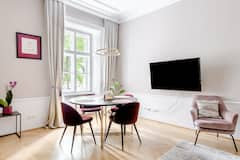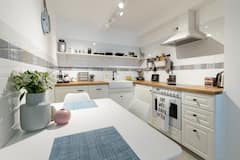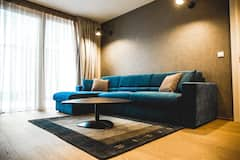The Hofburg Palace, or rather a series of palaces, is a striking complex whose appearance entirely matches its historical significance. The combination of various architectural styles, which are conveniently fitted into a harmonious unity, spans from the 13th to 20th century. Such setting was the centre of power of one of the most powerful and longest European dynasties – the Hapsburgs. The dynasty had witnessed the rise and decline of some of the most influential empires during its existence - Holy Roman, Austrian and finally Austro-Hungarian Empire.
What to look around (and within) the Hofburg

Created as a Bohemian fortress during the 13th century, then overtaken by the Hapsburgs at the second half of the same century and gradually converted into the principal palace, the Hofburg features several architectural styles. Baroque style is the prevailing one with Gothic, Renaissance, Neoclassicist, even Rococo styles that are quite noticeable.
The very centre of the Hofburg Palace can be entered through the Heldenplatz or Michaelerplatz gates. The rectangular courtyard, named In der Burg and flanked by a couple of structures, was built throughout the 16th (Amalientrakt), 17th (Leopoldinischertrakt) and 18th (Reichskanzleitrakt) centuries. Dominating features of the marvellous façade of the Michaelertrakt are sculptures depicting Hercules’s labours. Flanking fountains featuring dramatic scenes illustrate Austria’s dominion over the earth (the one with a male figure) and the sea (female figure). The Michaelertrakt is a semicircular structure, crowned with a turquoise dome.
Inner courtyards of the Hofburg Palace

The differences between the three buildings forming the In der Burg, which make perfect entirety despite divergence in their architecture, are best perceived from the inner courtyard.
The centre of the courtyard is occupied with a monument to Emperor Franz II (I). The only double emperor of all times who ruled the Holy Roman Empire (Franz II) before it was crushed by Napoleon I in 1805. Then, he became the ruler of the newly formed Austrian Empire (Franz I). His monument is adorned with female statues of Might, Faith, Peace and Justice. The Emperor is represented as a Roman, in toga.
The southern Leopoldinschertrakt, named after Emperor Leopold who had it created, is the official residence of the President, thus closed to the public. The Leopoldine Wing connected Amalientrakt (Amalia’s Wing) with the rest of the palace, and its inner façade differs from the outside one.
A story behind the Amalia's wing

The Amalia’s Wing, the one with a tower and a clock, was ordered by Rudolf, son of Maximilian II, who needed a residence separated from the main building. However, the name of the structure is devoted to Empress Amalia, who lived in this wing for 31 years after her husband, Joseph I, died during the smallpox epidemic. Beneath the octagonal tower, one can see a cannonball that was fired during the Ottoman siege of Vienna, in 1683, hammering the façade. Joking ☺. It’s a part of the lunar clock, created by Tycho Brahe (the 16th century), whose conclusions about the universe enabled revolutionary discoveries in this branch of science in the next several centuries. As the night arrives, the dark side of the ball, featuring the star imitations, replaces gradually the bright one.
You might be interested in these Airbnbs!
Beauty from the outside, wealth reflected inside

The northern Reichkanzleitrakt, right behind the Michaelertrakt Wing, is where official buildings of the Imperial Chancellery were situated. The winsome wing is embellished with ornate decoration, illustrating the symbols of the once mighty empire. The Reichkanzleitrakt and Amalientrakt house museums that are dedicated to the Imperial offices and private apartments, Empress Elisabeth (Sisi) and tableware.
Vienna Tour Guide

Ildiko
The historical centre of the Hofburg

The nucleus of the Hofburg is located within the Alte Burg (Old Palace), the site of the above-mentioned fortress whose four defensive towers were dismantled only in the 18th century. To enter this section of the palace, you need to pass through a distinctive Renaissance portal from the In der Burg, which leads into the Swiss Court, where the Imperial Chapel (the Hofburg’s oldest structure) and Imperial Treasury Museum are located. The present chapel dates to mid-15th century.
Neue Burg and Heldenplatz

The most distinctive wing of the Hofburg – the Neue Burg (New Wing) – overlooking the Heldenplatz (former military parade ground) is the latest addition. The most grandiose extension from the medieval beginnings coincided with the gradual downfall of the last empire.
Another semicircular structure of the complex was finished shortly before the outbreak of World War I (1913), which ended the existence of the Austro-Hungarian Empire (1918). The imposing two-story structure is decorated with Corinthian columns and features the monumental arch in the centre. It is decorated with the symbols of the empire and various allegorical sculptures. Arched windows at the base alternate with the statues depicting military, religious and other personalities and ranks of the Austrian history.
The Neue Burg is a setting for several museums, displaying collections of weapons and armours, musical instruments, the reliefs, etc.
The neighbouring Heldenplatz, the Square of the Heroes, is dominated by equestrian statues of the two significant military leaders. The French prince Eugene of Savoy, whose statue is closer to the Neue Burg, gained wide acknowledgment by fighting the Ottoman Turks off; the Archduke Karl was the Napoleon I’s direct opponent at Aspern (1809) and Wagram (1810).
Other establishments of the Hofburg Palace complex
Fans of nature shouldn’t bypass the greenhouse, called Schmetterlinghaus, where a myriad of interesting butterflies flies freely throughout the natural environment; the greenhouse is accessible through the Burggarten, a garden on the other side of the Neue Burg. Horse performances take place in the Winter Riding School, to the left of the Michaelertrakt Wing. At the far end of the complex, Albertina Museum, with the stunning collection of graphics, is another attention-worthy attraction.
History
Get Trip101 in your inbox
Unsubscribe in one click. See our Privacy Policy for more information on how we use your data




















Create an account to